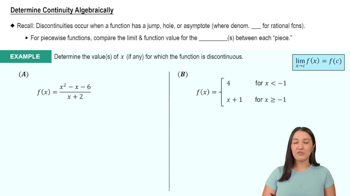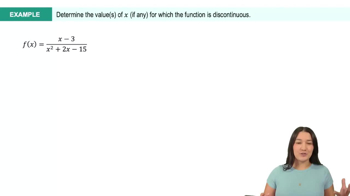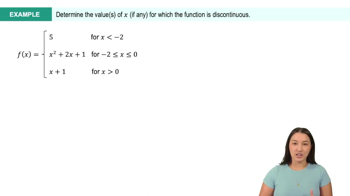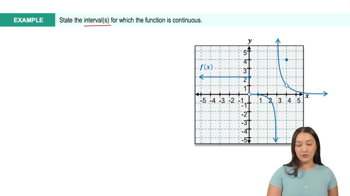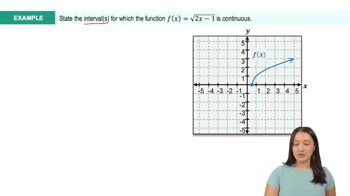Table of contents
- 0. Functions7h 52m
- Introduction to Functions16m
- Piecewise Functions10m
- Properties of Functions9m
- Common Functions1h 8m
- Transformations5m
- Combining Functions27m
- Exponent rules32m
- Exponential Functions28m
- Logarithmic Functions24m
- Properties of Logarithms34m
- Exponential & Logarithmic Equations35m
- Introduction to Trigonometric Functions38m
- Graphs of Trigonometric Functions44m
- Trigonometric Identities47m
- Inverse Trigonometric Functions48m
- 1. Limits and Continuity2h 2m
- 2. Intro to Derivatives1h 33m
- 3. Techniques of Differentiation3h 18m
- 4. Applications of Derivatives2h 38m
- 5. Graphical Applications of Derivatives6h 2m
- 6. Derivatives of Inverse, Exponential, & Logarithmic Functions2h 37m
- 7. Antiderivatives & Indefinite Integrals1h 26m
1. Limits and Continuity
Continuity
Problem 3.2.19a
Textbook Question
Use the graph of f in the figure to do the following. <IMAGE>
a. Find the values of x in (-2,2) at which f is not continuous.
 Verified step by step guidance
Verified step by step guidance1
Step 1: Understand the concept of continuity. A function f(x) is continuous at a point x = a if the following three conditions are met: (1) f(a) is defined, (2) the limit of f(x) as x approaches a exists, and (3) the limit of f(x) as x approaches a is equal to f(a).
Step 2: Examine the graph of f(x) over the interval (-2, 2). Look for any points where the function might not be continuous. These could be points where there is a jump, a hole, or a vertical asymptote in the graph.
Step 3: Identify any points of discontinuity. A point of discontinuity is where at least one of the conditions for continuity is not satisfied. Check for any breaks in the graph, such as gaps or jumps.
Step 4: Verify the type of discontinuity at each identified point. Determine if the discontinuity is removable (a hole in the graph), a jump (a sudden change in function value), or an infinite discontinuity (a vertical asymptote).
Step 5: List the x-values in the interval (-2, 2) where the function f(x) is not continuous, based on your observations from the graph.
Recommended similar problem, with video answer:
 Verified Solution
Verified SolutionThis video solution was recommended by our tutors as helpful for the problem above
Video duration:
3mPlay a video:
Was this helpful?
Related Videos
Related Practice





